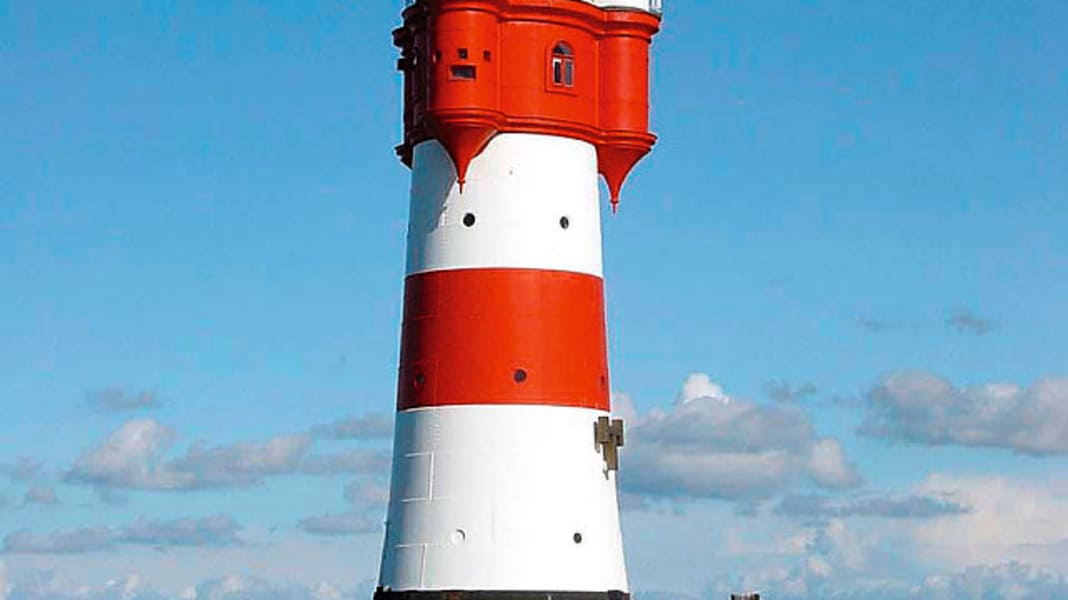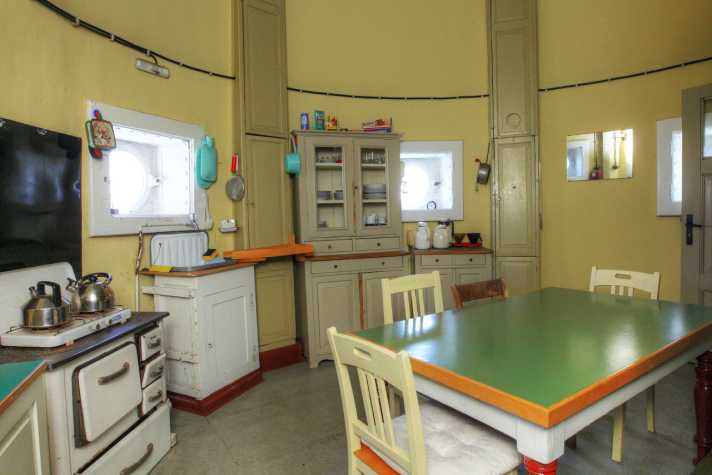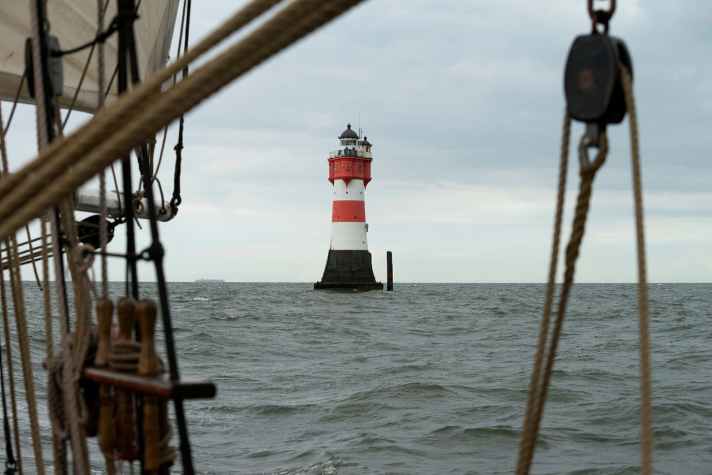"Roter Sand" lighthouse: New home port wanted - Bremerhaven is out of the running

- First offshore structure in the world
- Acutely threatened with collapse - the tower is to give way
- Four locations had submitted applications, now Bremerhaven has been eliminated
- Bremerhaven has its own lighthouse project
- Patience is required
- Visit the lighthouse while it is still standing!
First offshore structure in the world
For more than 140 years, the "Roter Sand" lighthouse has defied storms, waves and tides in the middle of the German Bight, a good 30 nautical miles north of Bremerhaven. It is considered the oldest offshore structure in the world and symbolises technical history and wanderlust in equal measure. It was the first tower ever to be built directly on the high seas between 1882 and 1885. A heavy steel shell, known as a caisson, was filled with concrete and masonry and sunk deep into the sandy seabed. It was the last greeting from home for emigrants, a visible escort from afar for those navigating from the high seas through the sands of the Weser estuary, until its fire was finally extinguished in 1964. In keeping with its rugged, exposed location, it could also stand defiantly against the sea. After all, with its red and white stripes, black base and caps, it bears the colours of the German Empire. Its towers are modelled on fortified castles. And yet: its roof resembles a pointed cap, the bay windows are adorned with cones and the conical shape appears compressed - it has a certain fairytale look. Perhaps it is this contrast that makes the landmark so popular. After its decommissioning, the "Roter Sand" lighthouse became a popular excursion destination. In the meantime, there was even the unusual opportunity to spend the night in the historic rooms of the tower and experience the special atmosphere on the open sea up close.
Acutely threatened with collapse - the tower is to give way
However, the harsh offshore conditions of the North Sea have taken their toll on it. The caisson, the mighty lower section of the tower, is now so badly damaged that it is in acute danger of collapsing. Experts from the German Foundation for Monument Protection have therefore decided to take an emotional and logistically challenging step: the upper, culturally valuable segment of the 53-metre-high, 70-tonne structure is to be cut off using a heavy-duty pontoon and special crane and carefully transported ashore. This is likely to be one of the most complex maritime salvage operations ever to take place on the German North Sea coast. In addition to the use of highly specialised cranes and floating heavy-duty platforms, the long transport route to the coast requires favourable weather and tidal conditions. However, the historic plinth must remain in place for reasons of technical feasibility and monument value.
The German Foundation for Monument Protection has been working intensively for years to preserve and save the maritime building, supporting restoration measures and engaging in public dialogue on the future of the historic tower. However, its bold plans are not being accepted without criticism - especially by the Red Sand Lighthouse Associationwhich believes that the significance of the building is inextricably linked to its location on the open sea. The association, whose members have dedicated countless hours of voluntary work to preserving the lighthouse, argues that the historical and emotional value of the lighthouse would be significantly impaired by moving it to land and is instead calling for a further examination of ways to preserve it on site.

Four locations had submitted applications, now Bremerhaven has been eliminated
Meanwhile, four coastal towns have got wind of the upcoming move and have applied to give the "Red Sand" a new home harbour; it should certainly be a crowd-puller. According to Steffen Skudelny, Chairman of the German Foundation for Monument Protection, an important criterion for the new location is the maritime environment: a place is being sought where the lighthouse has an unrestricted 'impression of water' on at least one side. This requirement limits the choice of possible locations. In addition to Bremerhaven, Hooksiel in the municipality of Wangerland (district of Friesland), the city of Wilhelmshaven and the harbour town of Fedderwardersiel in the municipality of Butjadingen (district of Wesermarsch) were also in the running.
However, according to a report in the "Nordsee Zeitung" newspaper, Bremerhaven has been out of the running since 15 April. The Weser-Jade-Nordsee Waterways and Shipping Authority (WSA) rejected the location, stating that the lighthouse with its red and white colouring could lead to confusion with the leading lights at a location in Bremerhaven and irritate shipping traffic. According to the WSA, approval would only be possible if the paintwork was changed significantly - to ash grey, for example. This, in turn, would have contradicted the requirements of the preservation order - and let's be honest: what would the tower be without its characteristic red and white stripes, dingy weather colours merging with the lead-grey sea?
With Bremerhaven's withdrawal, Fedderwardersiel, Wilhelmshaven and Hooksiel remain. Fedderwardersiel scores particularly well with its proximity to the original position of the lighthouse in the Outer Weser and the maritime atmosphere of an authentic shrimp cutter harbour. Hooksiel advertises with a location that is not only conveniently located in terms of transport, but also offers a view of the sea; Mayor Mario Szlezak sees the location of the town on the same longitude as the original site as a charming speciality. Wilhelmshaven, on the other hand, brings its excellent infrastructure and experience with maritime cultural projects into play. It remains exciting.
Bremerhaven has its own lighthouse project
The city of Bremerhaven, which is now no longer a possible location, would certainly have had experience with the challenges of saving historic lighthouses. The maritime city recently suffered a bitter loss: In August 2022, the striking red lighthouse on the northern pier of the Geest estuary was so badly tilted that it had to be removed without further ado. The cause was rotten foundation piles that were sinking under the pier head. In a dramatic rescue operation, at least the lantern, cupola and other striking parts of the beacon were salvaged. Reconstruction is currently being planned - true to the original and measured using modern measuring methods. A new, swivelled northern pier with a reconstructed beacon is intended to provide better infrastructure and increase the city's appeal, with completion scheduled for the end of 2026.
Patience is required
No final decision has yet been made, but the enthusiasm for the "Red Sand" project remains unbroken. In a survey conducted by the Nordsee-Zeitung and eagerly shared on social media by the respective fan groups, Fedderwardersiel recently emerged as the public's favourite, closely followed by Hooksiel. However, it is unclear when the final decision will be made. Where the unique historic lighthouse will ultimately play out its charisma - at least it is certain that its relocation is likely to be spectacular.

Visit the lighthouse while it is still standing!
Until then, lovers of maritime history still have the opportunity to experience it in its element. For pleasure boaters from the Jade and Weser, the view of the landmark is already routine. However, those who live or skipper further afield can still visit the tower, for example on one of the numerous cruises organised as part of the SAIL 2025 in Bremerhaven on traditional ships or more sporty on a Bénéteau 473 Oceanis Clipper at "Sailing partner North Sea" are offered. Even with a journey to Heligoland from Bremerhaven the passage of the tower is unavoidable. From the comfort of your sofa, for example, a Documentary of the NDR on a journey to the Weser estuary and the tower.

